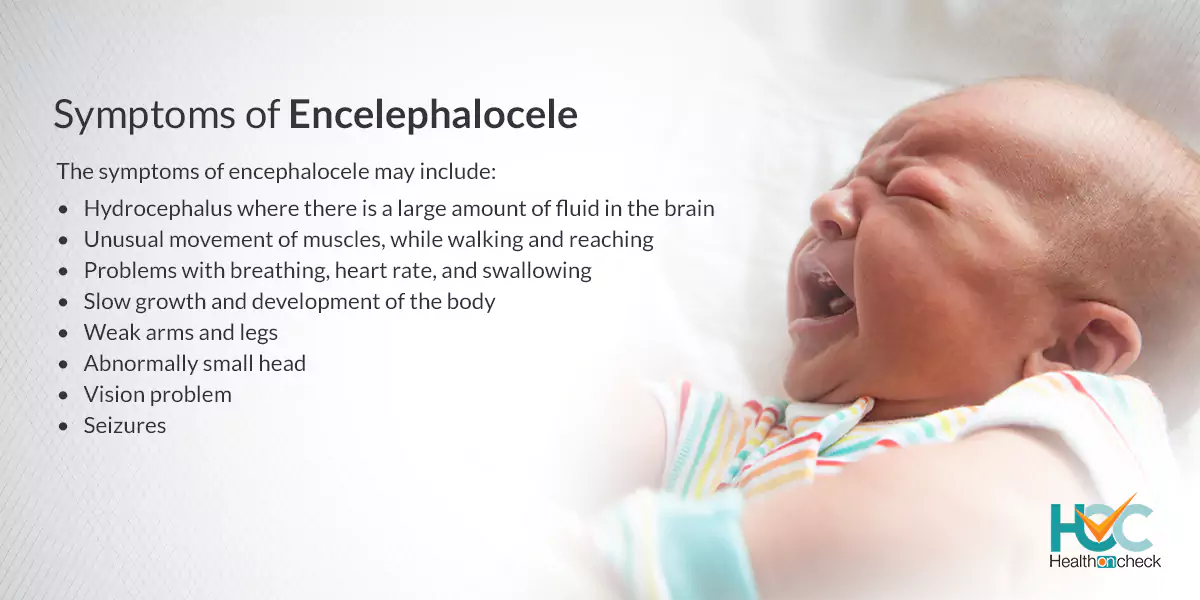All about Encelephalocele

What is Encelephalocele?
Encephalocele is a neural tube defect that affects the sac-like protrusions of the brain and the membranes that cover it across the openings in the skull. It is caused by the failure of the neural tube that is completely closed during foetal development. The encephaloceles lead to a groove down the middle of the skull, or between the forehead and nose, or on the back side of the skull. The severity of encephalocele differs based on its location. Babies with an encephalocele also have chromosome, brain, and facial problems.
What are the Types of Encelephalocele?
There are generally four types of encephaloceles, including:
Meningocele: This type of encephaloceles includes a defect in the skull, herniation of CSF (Cerebrospinal fluid), meninges, and neuroparenchyma. On MRI, it shows a clear-cut herniated sac with neuroparenchyma and CSF as its contents. The neuroparenchyma is frequently gliotic.
Meningo-encephalocele: In this type, there will be skull defect along with herniation of only CSF and meninges representing meningocele. On MRI it shows a distinct sac with contents that have signal intensity the same as CSF on all sequences with a specific defect in the skull. It is a serious condition that can cause long-term problems in the brain.
Atretic encephalocele: In this type, a fruste of encephaloceles consisting of the dura, fibrous tissue, and degenerated brain tissue forms and are most common in the parieto-occipital area and causes subscalp swelling.
Gliocele: This type of encephalocele consists of a glial-lined cyst containing CSF.
What are the Symptoms of Encelephalocele?
The symptoms of encephalocele may include:
- Hydrocephalus where there is a large amount of fluid in the brain
- Weak arms and legs
- Abnormally small head
- Unusual movement of muscles, while walking and reaching
- Slow growth and development of the body
- Vision problem
- Problems with breathing, heart rate, and swallowing
- Seizures
What are the Causes of Encephaloceles?
Researchers are not able to find out yet what causes encephaloceles. It seems there are a few factors that make it develop including several genetic syndromes that are linked with encephalocele. If a mother is having medical disorders, such as diabetes during pregnancy it may be connected with the development of encephalocele.
Factors like genetics and environment have been implicated in the development of an encephalocele. TORCH infections such as toxoplasma, rubella, cytomegalovirus, and herpes simplex virus have been involved in many cases of encephalocele. Getting married in the same gene pool and previous NTD pregnancies are also linked with the development of encephaloceles.
What are the Risk Factors of Encephalocles?
Babies who have a family history of neural tube defects like spina bifida or anencephaly are at risk of developing this condition. In such instances, the babies may have a genetic predisposition to developing a defect in their neural tubes and might develop an encephalocele. An individual who is genetically at the risk to get certain problems may carry a gene (or genes) for the disease, which may not surely be exhibited except if it is triggered or “activated” under some circumstances, including exposure to certain environmental factors. Getting exposed to toxic chemicals, like some medicines, may increase the risk of having a baby with encephalocele.
Some infections may also lead to developing encephalocele.
An encephalocele may arise as part of the above 30 various syndromes, such as Meckel syndrome, Fraser syndrome, Roberts syndrome, and Walker-Warburg syndrome. Amniotic band syndrome can also be linked with an encephalocele.
What are the Complications of Encelephalocele?
The complications of encephalocele in babies may include:
- Delays in the development of overall growth
- Long-term vision problems
- Problems in balancing and coordinating body movements
- Intellectual disability
- Hydrocephalus (fluid on the brain)
- Seizures.
What are the Treatment Options Available for Encelephalocele?
Surgery is needed among children with encephalocele to change the placement of brain tissue and rehabilitate the skull. Surgery is generally carried out within a few days or months after birth. An ultrasound MRI of the brain after birth team provides detailed information about the size and contents of the encephalocele which helps the doctors to do the surgery efficiently. It also helps to examine whether there are any other issues with the brain.
If there are issues regarding the other organs, like the heart or kidneys, more tests will be carried out such as an echocardiogram (ultrasound pictures of the heart) or renal (kidney) ultrasound. Blood samples may be taken for genetic testing.
Depending on the results of all the tests carried out both before and after birth, and careful examination of the baby, the medical team will discuss treatment options available that depend on the size of the encephalocele, its effect on the brain, and other conditions the baby may have. A lot of babies with encephalocele require surgery as a treatment option.
Surgery
The main aim of surgery is to change the position of any swelling brain tissue or spinal fluid back inside the skull and close the gap.
Along with surgery, some other medical procedures may be needed to:
– Relieve fluid build-up in the brain (hydrocephalus)
– Treat other defects
– Take care of medical problems that may appear with encephalocele
After surgery, your baby will be kept in the hospital’s NICU for further care and may need to be in a breathing machine till he/she is fully recovered from surgery. The duration of time the baby will be kept in the hospital depends on his condition and how he is recovering.
The baby will be allowed to be taken home once they are eating well and gaining weight properly.
Living with Encelephalocele
Usually, babies who have frontal encephalocele, with no linked syndrome or defects, and no brain tissue herniating into the sac have a good chance of survival. Babies with an encephalocele at the back of the head have a 55 percent survival rate. Fetal deaths and stillbirths are not uncommon and babies who live with encephaloceles often face various issues such as delays in development, no ability to see properly, balance and coordination problems, hydrocephalus (fluid on the brain), and seizures. Surgery is the only option to treat this problem and even after surgery, it’s very important to take proper care of the baby to make sure he/she is feeding and gaining weight well.
Whom to Consult?
While a primary clinician is almost always involved in the care of babies with the symptoms of encephalocele. Afterward, it is very important to consult with a professional team of specialists including an obstetrician, neurosurgeon, neurologist, intensivist, craniofacial specialist, and plastic surgeon to treat babies with this rare disease.





